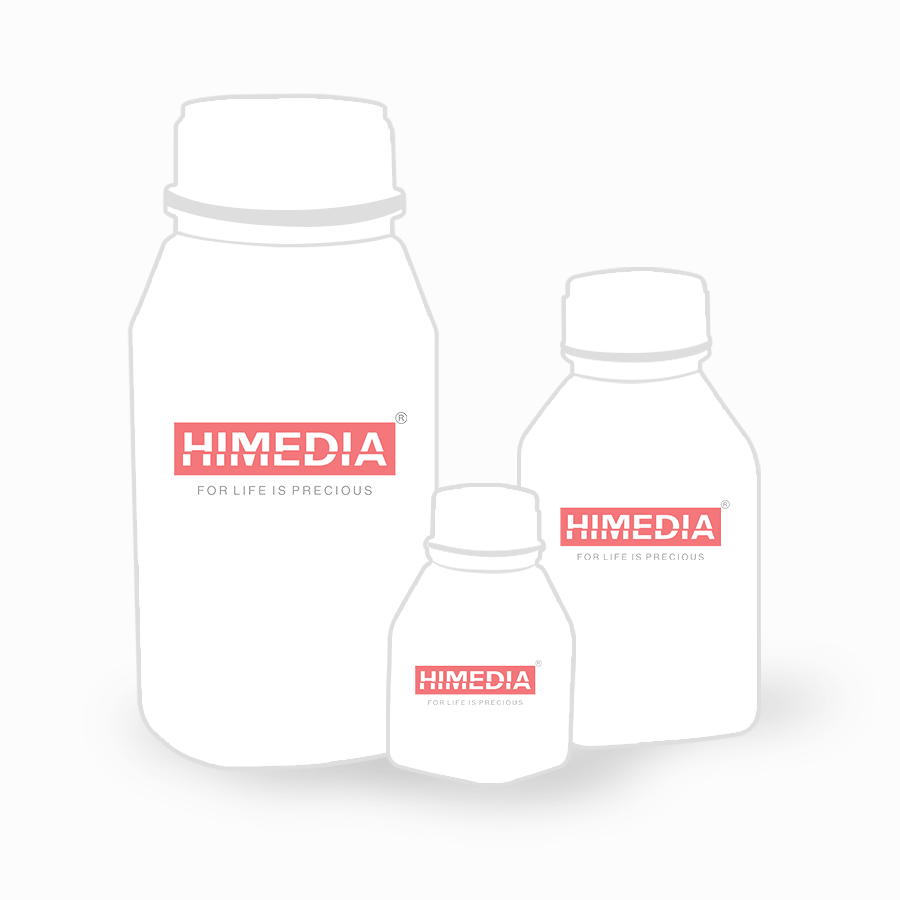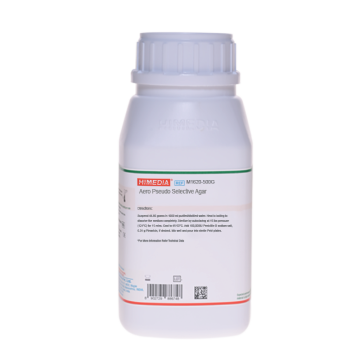 Your enquiry has been submitted
Your enquiry has been submitted
Aeromonas Selective Agar (BSIBG)
Intended Use
Recommended for the selective isolation of Aeromonas species from food and clinical samples.
Composition**
| Ingredients | g / L |
|---|---|
| HM peptone B # | 5.000 |
| Proteose peptone | 5.000 |
| D-Xylose | 10.000 |
| Sodium thiosulfate | 5.440 |
| Brilliant green | 0.005 |
| Neutral red | 0.025 |
| Bile salt | 8.500 |
| Irgasan | 0.005 |
| Agar | 11.500 |
Final pH ( at 25°C): 7.0±0.2
**Formula adjusted, standardized to suit performance parameters
# Equivalent to Beef extract
Directions
Suspend 45.48 grams in 1000 ml purified / distilled water. Heat to boiling to dissolve the medium completely. DO NOT AUTOCLAVE. Cool to 45-50°C. Mix well and pour into sterile Petri plates.
Principle And Interpretation
Aeromonas species occur widely in soil and water where these species cause disease in fish and amphibians. Also found in untreated and chlorinated drinking water, raw food and raw milk (1,2). It is observed that the major cause of gastrointestinal infections by Aeromonas species (1,3) is because of ingesting infected water (4,5).
The media was originally formulated for the selective isolation of Aeromonas species from faeces (6). Proteose peptone and HM peptone B provide essential nitrogenous compounds. D-xylose is source of carbon and energy. Gram positive organisms are inhibited by bile salts and brilliant green and gram negative organisms which possess a type A nitratase are inhibited by irgasan. Organisms which survive are differentiated by their ability to ferment xylose. Aeromonas species do not ferment xylose and oxidase test can be performed on colonies that do not produce acid. The current formulation of Aeromonas Selective Agar (BSIBG Agar) is recommended for the isolation of Aeromonas species from food which is better than that of ampicillin containing media.
Type of specimen
Clinical sample- Faeces ; Food and dairy samples, Water samples
Specimen Collection and Handling
For clinical samples follow appropriate techniques for handling specimens as per established guidelines (7,8). For food and dairy samples, follow appropriate techniques for sample collection and processing as per guidelines (9,10,11). For water samples, follow appropriate techniques for sample collection and processing as per guidelines (12). After use, contaminated materials must be sterilized by autoclaving before discarding.
Warning and Precautions
In Vitro diagnostic Use. For professional use only. Read the label before opening the container. Wear protective gloves/protective clothing/eye protection/ face protection. Follow good microbiological lab practices while handling specimens and culture. Standard precautions as per established guidelines should be followed while handling clinical specimens. Safety guidelines may be referred in individual safety data sheets.
Limitations
- Some strains may show poor growth due to nutritional variations.
- Further biochemical and serological tests must be performed for confirmation
Performance and Evaluation
Performance of the medium is expected when used as per the direction on the label within the expiry period when stored at recommended temperature.
Quality Control
Appearance: Light yellow to pink homogeneous free flowing powder
Gelling: Firm, comparable with 1.15% Agar gel.
Colour and Clarity of prepared medium: Reddish orange coloured clear to slightly opalescent gel forms in Petri plates.
Reaction: Reaction of 4.55% w/v aqueous solution at 25°C. pH : 7.0±0.2
pH: 6.80-7.20
Cultural Response: Cultural characteristics observed after an incubation at 35-37°C for 18-24 hours.
| Organism | Inoculum (CFU) | Growth | Recovery | Colony characteristics |
|---|---|---|---|---|
| Aeromonas hydrophila ATCC 7966 (00063*) | 50-100 | luxuriant | >=50% | transluscent colonies |
| Escherichia coli ATCC 25922 (00013*) | >=104 | inhibited | 0% | |
| Proteus mirabilis ATCC 25933 | >=104 | inhibited | 0% |
Key : (*) Corresponding WDCM numbers.
Storage and Shelf Life
Store between 10-30°C in a tightly closed container and the prepared medium at 20-30°C. Use before expiry date on the label. On opening, product should be properly stored dry, after tightly capping the bottle in order to prevent lump formation due to the hygroscopic nature of the product. Improper storage of the product may lead to lump formation. Store in dry ventilated area protected from extremes of temperature and sources of ignition. Seal the container tightly after use. Product performance is best if used within stated expiry period.
Disposal
User must ensure safe disposal by autoclaving and/or incineration of used or unusable preparations of this product. Follow established laboratory procedures in disposing of infectious materials and material that comes into contact with clinical sample must be decontaminated and disposed of in accordance with current laboratory techniques (7,8).
Reference
- Buchanan R. L. and Palumb S. A., 1985, J. Food Safety, 7:15.
- Steering Group on the Microbiological Safety of Foods (SGMSF) in Methods for Use in Microbiological Superveillance, 1994, MAFF, Ergon House, London SWIP3TR.
- Burke V. et al 1984, Appl. Environ. Microbiol., 48:361.
- George W. L., 1987, Clin. Microbiol., Newsletter 9, 121.
- Holmberg S. D., et al, 1986, Ann. Intern. Med., 105:683.
- Hunt,G.H., Price, E.H., Patel, U., Messenger, L., Stow, P. and Salter, P. (1987), Isolation of Aeromonas species from faecal specimens. J. Clin. Pathol. 40, 1382-1384.
- Isenberg, H.D. Clinical Microbiology Procedures Handbook 2nd Edition.
- Jorgensen, J.H., Pfaller, M.A., Carroll, K.C., Funke, G., Landry, M.L., Richter, S.S and Warnock., D.W. (2015) Manual of Clinical Microbiology, 11th Edition. Vol. 1.
- American Public Health Association, Standard Methods for the Examination of Dairy Products, 1978, 14th Ed., Washington D.C.
- Salfinger Y., and Tortorello M.L.2015, Compendium of Methods for the Microbiological Examination of Foods, 5th Ed., American Public Health Association, Washington, D.C.
- Wehr H. M. and Frank J. H., 2004, Standard Methods for the Microbiological Examination of Dairy Products, 17th Ed., APHA Inc., Washington, D.C.
- Lipps WC, Braun-Howland EB, Baxter TE,eds. Standard methods for the Examination of Water and Wastewater, 24th ed. Washington DC:APHA Press; 2023.
| Product Name | Aeromonas Selective Agar (BSIBG) |
|---|---|
| SKU | M1890 |
| Product Type | Regular |
| Physical Form | Powder |
| Origin | Animal |
| Packaging type | HDPE |
| References | 1.Hunt,G.H., Price, E.H., Patel, U., Messenger, L., Stow, P. and Salter, P. (1987), Isolation of Aeromonas species from faecalspecimens. J. Clin. Pathol. 40, 1382-1384.2.Steering Group on the Microbiological Safety of Foods (SGMSF) in Methods for Use in Microbiological Superveillance,1994, MAFF, Ergon House, London SWIP3TR.3.Buchanan R. L. and Palumb S. A., 1985, J. Food Safety, 7:15.4.Burke V. et al 1984, Appl. Environ. Microbiol., 48:361.5.George W. L., 1987, Clin. Microbiol., Newsletter 9, 121.6.Holmberg S. D., et al, 1986, Ann. Intern. Med., 105:683. |
| Customized Product Available | No |







